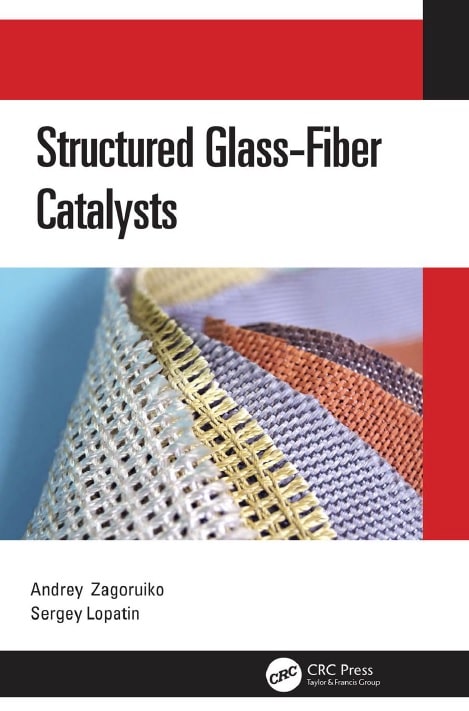
Contents
Preface xi
Acknowledgments xiii
About the Authors xv
Chapter 1 Current State of Research and Development in the
Field of Catalysts With Various Shapes and Their
Practical Application 1
1.1. Introduction 1
1.1. Traditional Catalyst Shapes 2
1.2. Fixed Beds of Granular Catalysts 2
1.3. Monolith Catalysts 4
1.4. Catalysts With Foam Supports 5
1.5. Catalysts With Flexible Metal Supports 6
References 8
Chapter 2 Glass-Fiber
Catalysts 11
2.1. General Description 11
2.2. Synthesis of Glass-Fiber
Catalysts 12
2.3. Platinum Catalyst IC-12-
S111 14
2.4. Copper-Chromite
GFC for the Deep Oxidation of
Organic Compounds 20
2.5. Vanadia and Iron Oxide Catalysts for the Oxidation
of Hydrogen Sulfide 28
2.6. Multilayer Composite Material With the Ternary
Layer of Nanofibrous Carbon 34
2.7. Conclusion 38
References 39
Chapter 3 Arrangement of the Beds of the Glass-Fiber
Catalysts 47
3.1. Structuring of the Microfibrous Catalysts 47
3.2. GFC Packing With the Propagative Flow of
Reaction Fluid 49
3.3. GFC Packing With the Gliding Flow or Reaction
Media 51
3.3.1. Cylindrical Cartridges 51
3.3.2. Prismatic Cartridges 53
3.3.3. Reinforced Cartridges 56
3.4. Lemniscate GFCs 57
References 59__
Chapter 4 Experimental Investigation of Pressure Drop and Mass
Transfer in GFC Packing 63
4.1. The Scope and Properties of the Research Objects 63
4.4.1. Experimental GFC Cartridges With the
Corrugated Metal Mesh Structuring
Elements 64
4.1.2. GFC Beds With the Lemniscate Structures 68
4.1.3. GFC Cartridges With the Flat Mesh
Structuring Elements 68
4.1.4. Reference Catalysts 71
4.2. Pressure Drop in GFC Cartridges 74
4.2.1. Experimental Technique 74
4.2.2. Experimental Results 75
4.2.3. Partial Anisotropy of GFC Cartridges 78
4.3. Investigation of Mass Transfer in GFC-Based
Cartridges 80
4.3.1. Experimental Technique 80
4.3.2. Experimental Results 82
4.3.3. Intrinsic Kinetics of the Toluene Oxidation
Pt/GFCs 89
4.3.4. Intra-Thread
Diffusion Limitations 91
4.3.5. On the Intra-Fiber
Mass Transfer 92
4.3.6. External Diffusion Limitations in the
GFC Cartridges 95
4.3.7. Verification of the Mass Transfer Limitation
Model 100
4.4. Conclusion 102
References 103
Chapter 5 Development and Application of Commercial and
Pilot-Scale
GFC-Based
Processes 105
5.1. GFC-Based
Processes for the Abatement of Toxic
Organic Compounds in Waste Gases 105
5.1.1. Process for VOC Deep Oxidation in the
Waste Gases of a Synthetic Rubber Plant 105
5.1.2. Process for the Purification and Cooling
of the Exhausts From a Stationary Diesel
Power Plant 109
5.2. GFC-Based
Processes of Environmentally Safe
Combustion of Fuels 117
5.2.1. Combustion of Solid Fuels in the Fluidized
Beds of the Dispersed Heat Carrier Using
Reinforced GFC Cartridges 117
5.2.2. Catalytic Air Heaters on the Base of GFCs 119
5.3. Sulfur Dioxide Oxidation Processes at
Pt-Containing
GFCs 121
5.3.1. Processes of SO2 Oxidation in Sulfuric
Acid Production 122
5.3.2. Reverse-Flow
Process With the Additional
GFC Beds for Smelter Gas Processing,
Which Contains CO and SO2 124
5.3.3. Conditioning of Flue Gases from
Coal-Fired
Power Plants 130
References 135
Conclusions 139
Index……………………… 141
Preface
The development of novel catalytic processes or efficiency improvements of existing ones is an important task, having a high practical value in such areas as chemistry, petrochemistry, oil processing, environmental protection, and in particular in the abatement of toxic atmospheric pollutants from automobile transport and industrial and energy manufacturing facilities.
One of the most promising methods for the solution of this task is the development of processes on the base of catalysts with a new geometric shape, which are characterized by higher efficiency of heat and mass transfer, thus providing for the maximum use of the catalytic potential of the catalysts’ active components.
The breakthrough in this area can be achieved owing to the application of novel catalysts on the base of glass-fiber supports. The most important distinction between glass-fiber catalysts (GFCs) and traditional catalysts is their specific geometric structure, high mechanical strength, and flexibility, opening up unique possibilities for the creation of new types of differently shaped structured beds with reduced pressure drop and improved heat and mass transfer. This, in turn, makes it possible to create new designs of catalytic reactors.
At the same time, the specificity of such catalysts raises certain problems with regard to their practical application. In particular, until now, the various packings of microfibrous catalysts have not yet been studied fully enough in regard to the quantitative description of heat and mass transfer processes, and it significantly complicates the scale up and optimization of GFC-based reactors. In many cases, we may face practical difficulties in incorporating GFCs into existing reactors, which were designed to use the conventional catalysts’ shapes (pellets or monoliths). The current text is dedicated to the issues of the synthesis and investigation of GFCs, as well as to development of the engineering basis for the commercial catalytic processes applying these catalysts.
